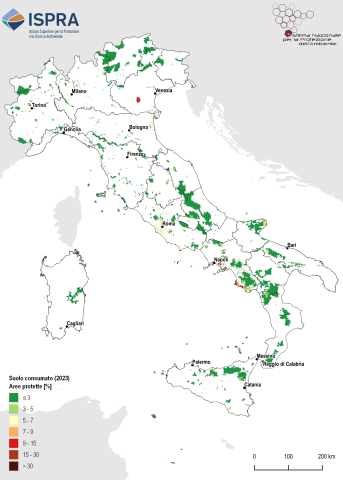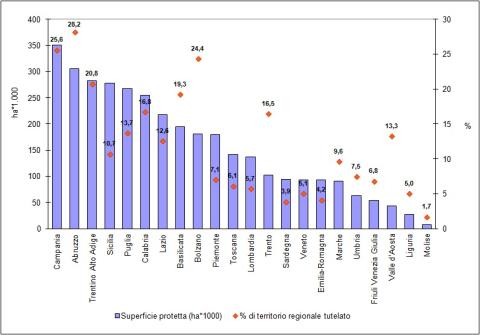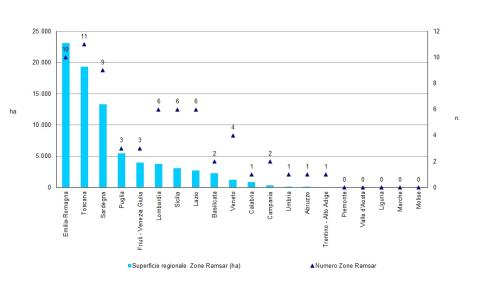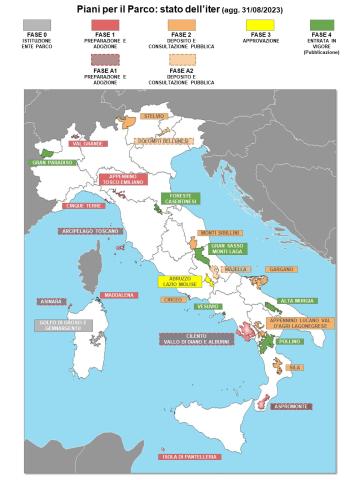SOIL CONSUMPTION IN PROTECTED AREAS
Data aggiornamento scheda:

Within the areas included in the EUAP (Official List of Protected Areas), the total soil consumption in 2023 amounted to 58,601 hectares (1.9% of the protected territory). The soil consumption recorded between 2022 and 2023 was nearly 70 hectares. The highest values were observed in Campania (3.8%) and Veneto (3.2%), the only regions exceeding the 3% threshold of consumed territory within protected areas. Overall, between 2006 and 2023, a total of 1,767 hectares were lost within Italian protected areas.
NATURA 2000 NETWORK
Data aggiornamento scheda:
The Natura 2000 Network in Italy consists of 2,646 sites, covering a total area, net of overlaps, of 5,845,078 hectares on land, equivalent to 19.4% of the national territory, and 2,301,047 hectares at sea, corresponding to 6.4% of territorial waters (data updated to December 2023). A total of 643 Special Protection Areas (SPAs) and 2,364 Sites of Community Importance-Special Areas of Conservation (SCI-SACs) have been designated (of which 361 are SCI-SACs coinciding with SPAs). In December 2022, the sites numbered 2,639, with an increase of 7 units in the past year and an expansion of 163 hectares on land and 229,358 hectares at sea. The coverage percentages of the Natura 2000 Network vary across Italian regions and autonomous provinces, ranging from 12% to 36% on land and from less than 1% to 30% at sea.
The national coverage of the Network is significant in relation to the targets of the EU Biodiversity Strategy for 2030 (SEB2030), which calls for expanding protected areas in the EU to reach at least 30% of terrestrial and 30% of marine areas. The SEB2030 target includes all areas subject to protection measures, such as Natura 2000 sites, National and Regional Parks, and other protected areas. At the regional level, Abruzzo and Valle d’Aosta meet the SEB2030 target, with Natura 2000 sites covering 36% and 30% of their territories, respectively. Other regions approaching the target include the Autonomous Province of Trento (28%), Molise (27%), Campania (27%), and Liguria (26%). The protection percentages of Natura 2000 marine sites are lower, with only Puglia (30%) and Tuscany (27%) having protection levels close to the target.
NATIONAL PROTECTED LAND AND MARINE AREA
Data aggiornamento scheda:
The European Commission has adopted the European Biodiversity Strategy for 2030 (SEB 2030, COM(2020) 380 final), which sets the objective for Member States to protect at least 30% of their national territory and 30% of their seas, with at least one-third of these areas being strictly protected. These objectives are also incorporated into the National Biodiversity Strategy for 2030 (SNB 2030).
The indicator integrates spatial data from the main biodiversity protection systems existing in Italy (protected areas and the Natura 2000 Network), calculating the current protected surface both on land and at sea. It evaluates the variation from 1991 to 2023 and highlights the gap between the percentage of protected land and marine areas and the 30% target set by SEB 2030. The data used to calculate the extent of the protected area come from CDDA and the Natura 2000 database. Other Effective Area-based Conservation Measures (OECM) are not included, as the types of areas that may fall within this category have not yet been defined.
As of today, the total national coverage of protected areas, after accounting for overlaps between protected areas and Natura 2000 sites, is approximately 4,068,476 hectares at sea, equivalent to 11.62% of Italian territorial waters and the Ecological Protection Zone (ZPE), and about 6,532,341 hectares on land, covering 21.68% of the national territory. The extent of overlapping areas, i.e., those falling within both a protected area and a Natura 2000 site, has increased over time, reaching 862,631 hectares at sea and 2,447,046 hectares on land in 2023. The trends indicate that the percentage of protected national surface has stabilized since 2006 for marine areas and since 2011 for land areas. To meet the 30% target set by SEB 2030, an additional 18% of marine areas (approximately 6,600,000 hectares) and 8% of land areas (approximately 2,500,000 hectares) still need to be protected.
TERRESTRIAL PROTECTED AREAS
Data aggiornamento scheda:

In Italy, as of today, 843 terrestrial protected areas (including those with a marine component) have been established, covering a total protected surface of over 3 million hectares, which corresponds to approximately 10.5% of the national terrestrial area. Analyzing the historical series (1922-2019), it is possible to observe, especially from the mid-1970s onward, a positive trend in terms of both the number and surface area of terrestrial protected natural areas. However, since 2008-2009, there has been a certain stabilization in the growth trends.
WETLANDS OF INTERNATIONAL IMPORTANCE
Data aggiornamento scheda:

The Italian wetlands currently included in the official list of sites under the Ramsar Convention are 57, covering a total of 72,288 hectares. Additionally, three Ministerial Decrees were issued in 2011, 2013, and 2016 for the establishment of nine more areas. In total, the 66 Italian Ramsar sites (57 designated and 9 in the process of designation) are distributed across 15 regions, covering 79,826 hectares. The regions with the largest and most numerous areas are Emilia-Romagna (10 areas, 23,112 ha), Tuscany (11 areas, 19,306 ha), and Sardinia (9 areas, 13,308 ha).
The level of implementation of protection and management measures for these areas is not sufficiently known, despite being essential to ensure the conservation of habitats, flora, and fauna.
IMPLEMENTATION STATUS OF PLANNING IN NATIONAL PARKS
Data aggiornamento scheda:

The indicator, referring to the 25 National Parks established as of 08/31/2023, represents the implementation status of Park Plans under Article 12 of Law 394/1991 within the complex process of drafting - adoption - approval by the competent authorities. Compared to 2020, the number of active plans has increased by one unit (Pollino National Park), reaching a total of 12. However, a general delay persists, particularly regarding plans pending approval. Considering the legal timeframe for the entry into force of a Park Plan, all National Parks (NPs) should have had an active plan by now. Instead, an average delay of 21 years in the approval process has been recorded.
MARINE PROTECTED AREAS
Data aggiornamento scheda:
The number of areas and the extent of protected marine surface have steadily increased over time. Currently, Italy has 39 Marine Protected Areas (MPAs), established in 10 Italian regions; of these, 29 are Marine Protected Areas (AMPs). Sicily and Sardinia are the regions with the highest number of marine protected areas, both in terms of quantity and protected marine surface.
Between 2012 and 2019, the national surface area of MPAs increased by 1.9%, thanks to the establishment in 2018 of two Marine Protected Areas: Capo Testa - Punta Falcone in Sardinia and Capo Milazzo in Sicily.
OVERLAP OF TERRESTRIAL PROTECTED AREAS WITH KEY BIODIVERSITY AREAS
Data aggiornamento scheda:
In order to assess whether protected areas have been designated based on scientific criteria, including ecologically representative areas (Margules & Pressey, 2000; Maxwell et al., 2020), the overlap between terrestrial protected areas in our country and Key Biodiversity Areas (KBA, IUCN, 2016) has been calculated. The protected areas considered include those in the data bank of the Common Database on Designated Areas (CDDA) (now Nationally designated areas of Europe - NatDA), and the Natura 2000 Network. KBAs identify key areas for biodiversity conservation and, according to the European Commission’s guidance document on achieving the 30% target ("Criteria and guidance for protected areas designations," Brussels, 28/1/2022), are among those to be considered for designation as protected areas. The indicator used corresponds to the one adopted internationally to evaluate progress toward the Sustainable Development Goals (SDGs) for 2030 (SO4-3.T1: National estimates of the average proportion of Terrestrial KBAs covered by protected areas in %).
The results indicate that, after accounting for overlaps between CDDA protected areas and Natura 2000 sites, 75.20% of the national terrestrial protected area overlaps with KBAs identified at the national level, demonstrating a fair inclusion of important biodiversity areas.
ANTHROPOGENIC PRESSURE IN WETLANDS OF INTERNATIONAL IMPORTANCE
Data aggiornamento scheda:
A significant portion of Italy’s Ramsar sites is subject to anthropogenic pressure due to both the presence of settlements and infrastructure and agricultural activities. In 45 out of 65 cases, agricultural areas occupy more than half of the Ramsar site's territory. While urbanized areas and infrastructure have a smaller spatial extent, they still contribute to the pressure affecting Ramsar sites. Approximately one-quarter of these areas experience high or very high levels of urbanization pressure. A total of 68% of wetlands fall within Class III (high pressure) and Class IV (very high pressure), highlighting the fragile balance in which these environments exist. Only 15% of the areas fall into Class I (low pressure), while 17% belong to Class II (moderate pressure).